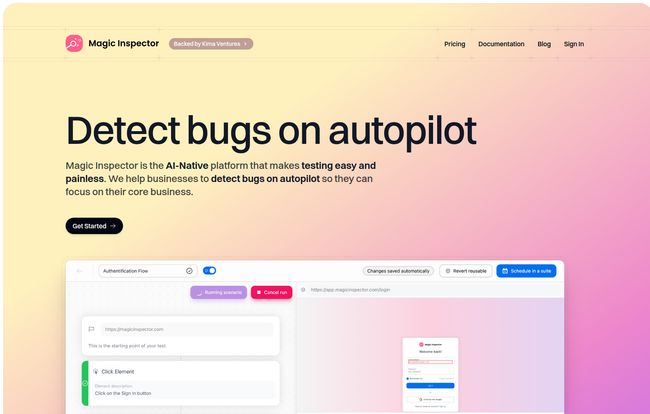You and me. For years, we’ve been hearing about the promise of test automation. The dream of a bug-free world where robots do all the tedious clicking and we, the brilliant humans, focus on strategy. But what’s the reality been? Clunky frameworks, flaky tests, and the need to basically become a developer just to check if a login form works. I’ve spent more nights than I care to admit wrestling with Selenium locators that break if a developer so much as sneezes near the CSS. It’s exhausting.
So when a tool comes along with a name like Magic Inspector and a promise to “Detect bugs on autopilot,” my inner skeptic raises a well-trained eyebrow. But my inner, overworked SEO-guy who just wants things to work... he leans in a little closer. This tool claims you can automate browser testing using plain English. No code. No CSS selectors. No XPath voodoo. Just… words. Is it really magic? Let’s find out.
So What Exactly is Magic Inspector?
At its core, Magic Inspector is an AI-native test automation platform built for the rest of us. It’s for the product managers, the manual QA folks, the startup founders wearing a dozen hats, and anyone who thinks “XPath” sounds like a villain from a sci-fi movie. The whole idea is to strip away the technical barriers that have made test automation a specialized, code-heavy discipline.

Visit Magic Inspector
Instead of writing lines of code, you give the platform instructions in natural language. Think about it. You’re not programming a robot; you’re directing a very capable, very literal assistant. You’d say something like:
Click on the 'Sign Up' button.
Type 'my-super-secret-password' into the password field.
Check if the text 'Welcome back!' is visible.
The AI handles the rest. It intelligently identifies the elements on the page without you needing to point it to `div.class-name-123 > button#submit-btn`. This, right here, is the paradigm shift. It's moving the power from the person who can write the code to the person who understands the product's user flow.
The AI-Powered Features That Actually Matter
A shiny UI is nice, but as we all know, it’s the engine under the hood that gets you across the finish line. Magic Inspector packs a few features that I found genuinely impressive.
Natural Language is the Star of the Show
I can’t stress this enough. The ability to write test steps in plain English is a massive win. This democratizes the whole process. Your marketing manager could write a test to ensure a new landing page form works. Your product owner can verify a new user onboarding flow themselves. This breaks down silos and speeds up the feedback loop immensely. It's the difference between describing a bug in a Jira ticket and just building a test that proves the bug exists.
True Autopilot with Scheduling and CI/CD
Creating tests is one thing. Running them consistently is another. Magic Inspector lets you schedule your tests to run whenever you want—every hour, every night, you name it. More importantly for the dev-savvy folks, it integrates directly into your CI/CD pipeline (think Jenkins, GitHub Actions, etc.). This means every time a developer pushes new code, your suite of plain-English tests can run automatically, catching regressions before they ever make it to production. That's the autopilot dream.
Speeding Things Up with Parallel Execution
If you have a lot of tests, running them one by one can take forever. Parallel execution is the answer. It’s like opening up more checkout lanes at the grocery store. Magic Inspector can run multiple tests at the same time, drastically cutting down the time you have to wait for results. For a fast-moving team, this isn't a luxury; it's a necessity.
Video Recordings for Ultimate Clarity
This might be my favorite part. When a test fails, Magic Inspector provides a full video recording of the session. Gone are the days of "well, it works on my machine." You can see exactly what the AI saw and where things went wrong. You can send this video to a developer, and there’s no ambiguity. It’s the ultimate proof, and it saves so much time in back-and-forth communication.
The Realities of Using an AI Tool
Okay, let's ground ourselves for a second. While the tool feels like a bit of magic, it’s not without its trade-offs. Here’s my honest take.
| What I'm Excited About (The Pros) | A Few Things to Consider (The Cons) |
|---|---|
| Insanely accessible. You genuinely don't need to be a programmer to get value from this on day one. It empowers the whole team. | Trust in the AI. You're relying on the AI to correctly identify elements. If your site has very generic buttons, it might get confused. |
| Blazing fast bug detection. The combination of scheduling and CI/CD integration means you find bugs way earlier in the cycle. | It's a paid tool. The best features are going to be on a paid plan. This is standard, but something to budget for. |
| Video proof is a godsend. It cuts down on debugging time and miscommunication between QA and dev teams. | Less granular control. For hyper-specific, edge-case tests, a traditional code-based solution might still offer more raw power and customization. |
How Much Does Magic Inspector Cost?
The dreaded pricing question. Based on their website, they follow a pretty standard SaaS model with tiered plans. You’ve got:
- Pro: Positioned for small startups getting their feet wet with automation.
- Elite: Aimed at growing teams that need more capacity and features.
- Enterprise: For large organizations that require dedicated infrastructure and support.
They don't list the exact numbers on the main page, which is pretty common. You'll likely have to head over to their official pricing page or get in touch for a quote, especially for the Enterprise plan. I'd recommend starting with their free trial to see if it fits your workflow before you pull out the company card.
So, Should You Give It a Shot?
Here’s my final take. If you’re on a team of hardcore SDETs (Software Development Engineer in Test) who love building complex automation frameworks from scratch in Cypress or Playwright, this probably isn't for you. You value the granular control that code provides.
But if you are on a team where testing is a bottleneck? If your product managers and manual QAs want to contribute but lack the coding skills? If you're a startup founder who needs to move fast and can't afford a dedicated automation engineer? Then yes. Absolutely. You should be looking at Magic Inspector or tools like it. The time you save and the bugs you catch early will almost certainly be worth the investment.
This is the direction the industry is heading—smarter, more accessible tools that empower more people. Its not about replacing developers, but about freeing them up to work on complex problems while others handle the critical, but repetitive, task of regression testing.
Frequently Asked Questions about Magic Inspector
- 1. Do I really need zero coding knowledge to use Magic Inspector?
- Pretty much, yes. The whole point is to use natural language instructions like "Click the login button." If you can describe what a user needs to do on your site, you can build a test for it.
- 2. How is this different from tools like Selenium or Cypress?
- The main difference is the abstraction layer. Selenium and Cypress are code-based frameworks. You write JavaScript, Python, or another language to control the browser. Magic Inspector is a no-code platform where you use English, and their AI translates that into browser actions.
- 3. Can Magic Inspector handle dynamic content or complex user flows?
- Yes, it's designed for that. The platform includes features for managing variables and secrets, which means you can test complex scenarios like signing up a new user, using their details to log in, and then performing actions—all in one continuous test.
- 4. What integrations does it support?
- It's built for modern workflows. Key integrations include CI/CD tools (like Jenkins, GitHub Actions) to automate testing within your development pipeline, and notification tools (like Slack or email) to alert you when tests fail.
- 5. Is there a free trial available for Magic Inspector?
- Yes, the website prominently features a call to action to "Start your free trial today." This is the best way to evaluate the tool with your own web application before committing to a plan.
My Final Word
Look, the quest for better, faster, and easier QA is never-ending. Magic Inspector isn't a silver bullet that will eliminate all bugs forever. No tool is. But it represents a significant step in the right direction. By lowering the barrier to entry and putting powerful automation into the hands of non-coders, it helps teams build more reliable products. It’s less about the 'magic' and more about smart, accessible design. And in my book, that's a pretty good trick.



